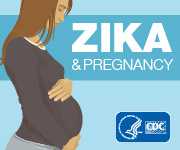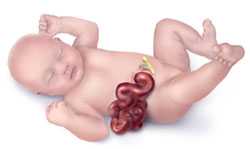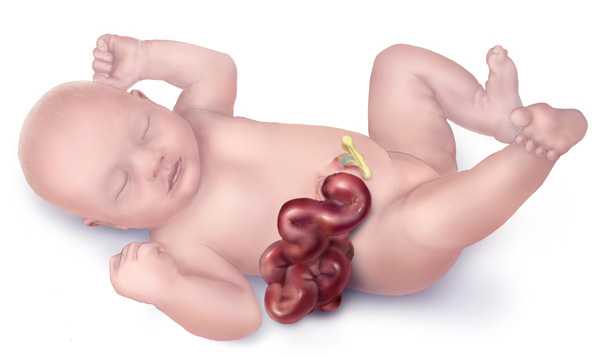Facts about Gastroschisis
Gastroschisis (pronounced gas-troh-skee-sis) is a birth defect of the abdominal wall. The baby’s intestines are found outside of the baby’s body, exiting through a hole beside the belly button.
What is Gastroschisis?
Gastroschisis is a birth defect of the abdominal (belly) wall. The baby’s intestines are found outside of the baby’s body, exiting through a hole beside the belly button. The hole can be small or large and sometimes other organs, such as the stomach and liver, can also be found outside of the baby’s body.
Gastroschisis occurs early during pregnancy when the muscles that make up the baby’s abdominal wall do not form correctly. A hole occurs which allows the intestines and other organs to extend outside of the body, usually to the right side of belly button. Because the intestines are not covered in a protective sac and are exposed to the amniotic fluid, the intestines can become irritated, causing them to shorten, twist, or swell.
Ashley's Story

Ashley was born with gastroschisis. Read her story as well as other stories from families affected by gastroschisis »
Other Problems
Soon after the baby is born, surgery will be needed to place the abdominal organs inside the baby’s body and repair the hole in the abdominal wall. Even after the repair, infants with gastroschisis can have problems with nursing and eating, digestion of food, and absorption of nutrients.
Occurrence
The Centers for Disease Control and Prevention (CDC) estimates that about 1,871 babies are born each year in the United States with gastroschisis, but several studies show that recently this birth defect has become more common, particularly among younger mothers.1-3
Causes and Risk Factors
The causes of gastroschisis among most infants are unknown. Some babies have gastroschisis because of a change in their genes or chromosomes. Gastroschisis might also be caused by a combination of genes and other factors, such as the things the mother comes in contact with in the environment or what the mother eats or drinks, or certain medicines she uses during pregnancy.
Like many families affected by birth defects, CDC wants to find out what causes them. Understanding factors that are more common among babies with birth defects will help us learn more about the causes. CDC funds the Centers for Birth Defects Research and Prevention, which collaborate on large studies such as the National Birth Defects Prevention Study (NBDPS; births 1997-2011) and the Birth Defects Study To Evaluate Pregnancy exposureS (BD-STEPS, which began with births in 2014), to understand the causes of and risks for birth defects, like gastroschisis.
Recently, CDC researchers have reported important findings about some factors that affect the risk of having a baby with gastroschisis:
- Younger age: teenage mothers were more likely to have a baby with gastroschisis than older mothers.2,3
- Alcohol and tobacco: women who consumed alcohol or were a smoker were more likely to have a baby with gastroschisis.4,5
CDC continues to study birth defects like gastroschisis in order to learn how to prevent them. If you are pregnant or thinking about getting pregnant, talk with your doctor about ways to increase your chance of having a healthy baby.
Diagnosis
Gastroschisis can be diagnosed during pregnancy or after the baby is born.
During Pregnancy
During pregnancy, there are screening tests (prenatal tests) to check for birth defects and other conditions. Gastroschisis might result in an abnormal result on a blood or serum screening test or it might be seen during an ultrasound (which creates pictures of the baby’s body while inside the womb).
After the Baby is Born
Gastroschisis is immediately seen at birth.
Treatments
Soon after the baby is born, surgery will be needed to place the abdominal organs inside the baby’s body and repair the defect.
If the gastroschisis defect is small (only some of the intestine is outside of the belly), it is usually treated with surgery soon after birth to put the organs back into the belly and close the opening. If the gastroschisis defect is large (many organs outside of the belly), the repair might done slowly, in stages. The exposed organs might be covered with a special material and slowly moved back into the belly. After all of the organs have been put back in the belly, the opening is closed.
Babies with gastroschisis often need other treatments as well, including receiving nutrients through an IV line, antibiotics to prevent infection, and careful attention to control their body temperature.
Other Resources
The views of this organization are its own and do not reflect the official position of CDC.
- Avery’s Angels
Avery’s Angels is a foundation that helps children and families affected by gastroschisis. The website has resources for connecting with other families and ways to raise awareness about gastroschisis.
References
- Parker SE, Mai CT, Canfield MA, Rickard R, Wang Y, Meyer RE, et al; for the National Birth Defects Prevention Network. Updated national birth prevalence estimates for selected birth defects in the United States, 2004-2006. Birth Defects Res A Clin Mol Teratol. 2010;88(12):1008-16.
- Kirby RS, Marshall J, Tanner JP, et al.; for the National Birth Defects Prevention Network. Prevalence and correlates of gastroschisis in 15 states, 1995 to 2005. Obstet Gynecol. 2013 Aug; 122 (2 Pt 1):275-81.
- Jones AM, Isenburg J, Salemi JL, et al.; for the National Birth Defects Prevention Network. Increasing prevalence of gastroschisis—14 States, 1995-2012. MMWR morb Mortal Wkly Rep. 2016 Jan 22;65(2):23-6.
- Bird TM, Robbins JM, Druschel C, Cleves MA, Yang S, Hobbs CA, & the National Birth Defects Prevention Study. Demographic and environmental risk factors for gastroschisis and omphalocele in the National Birth Defects Prevention Study. J Pediatr Surg. 2009;44:1546-1551.
- Feldkamp ML, Reefhuis J, Kucik J, Krikov S, Wilson A, Moore CA, Carey JC, Botto LD and the National Birth Defects Prevention Study. Case-control study of self reported genitourinary infections and risk of gastroschisis: findings from the National Birth Defects Prevention Study, 1997-2003. BMJ. 2008; 336(7658): 1420-3.
- Page last reviewed: June 27, 2017
- Page last updated: June 27, 2017
- Content source:



 ShareCompartir
ShareCompartir

